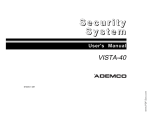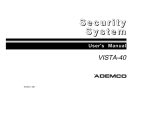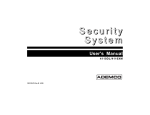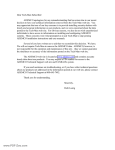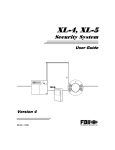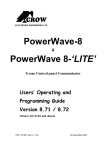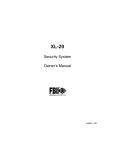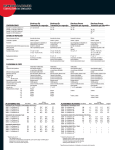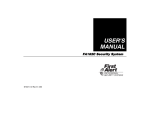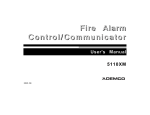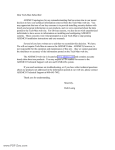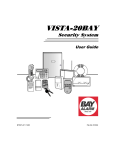Download FBI XL-1t - Eastern Electronics & Security
Transcript
XL-1Turbo
Security System
User Guide
A Subsidiary of Pittway Corp.
N9884
08/98
Quick Reference
Turn System On
Check to make sure the system is READY - Green ready light is lit
Enter your four digit user code - the On/Off (Arm) light will light
Exit through a door designated by your installer as an exit/entry door.
Turn System Off
Enter through a door designated by your installer as an exit/entry
door.
Enter your four digit user code
The System On (Arm) light will go out
Turn System On and Stay Inside
Check to make sure the system is READY - Green ready light is lit
STAY
Followed by your user code
The On/Off (arm) light and the Stay light will both light
REMEMBER: You must turn the system off if you want to open the
door or leave the premises after the exit time has passed.
Turn The System On: Perimeter Sensors Instant Mode and Stay Inside
Check to make sure the system is READY - Green ready light is lit
INSTANT
STAY
Followed by
Followed by your user code
The On/Off light, the Instant light and the Stay light will all be on
Smoke Detector Reset
Enter your four digit user code
Alarm Company Service Number _____________
–2–
Table of Contents
Introduction ...................................................................................................................4
System Reference...........................................................................................................5
Turning The System On And Off...................................................................................6
Turn the System On and Leave .................................................................................6
Not Ready ...................................................................................................................6
To Turn the System On - Not Ready..........................................................................7
Turn System On and Stay Inside...............................................................................7
Turn the System On: Perimeter Sensors Instant Mode and Stay Inside..................8
Bypass .........................................................................................................................8
Unbypass ....................................................................................................................9
Turn the System Off ...................................................................................................9
User Codes ...................................................................................................................11
Add or Change a User Code .....................................................................................11
Delete a User Code ...................................................................................................11
Keypad Send Help Conditions.....................................................................................12
Send Help Conditions ...............................................................................................12
Duress .......................................................................................................................12
Quick Commands.........................................................................................................13
Quick On - (Quick Arming).......................................................................................13
Quick Forced On .......................................................................................................13
Quick Bypass ............................................................................................................13
Set Time/Date ...........................................................................................................14
Turn Chime On/Off ......................................................................................................15
Keypad Indicators and Keys........................................................................................16
Testing the System ......................................................................................................18
System Test ..............................................................................................................18
Battery Test ..............................................................................................................18
Glossary .......................................................................................................................19
Recommendations For Proper Protection....................................................................22
Recommendations For Smoke And Heat Detectors .................................................22
Recommendations For Proper Intrusion Protection ................................................23
–3–
Introduction
Congratulations on your decision to protect your home or business
with the XL-1T security system. You have chosen a reliable, state of
the art security system that is remarkably easy to operate. Your
system has been professionally installed by your local Security
Company who can explain the specifics of your system.
The keypad is the input and display device for your security system.
The following keypad models can interact with your system. Your
Security Company will suggest the model most appropriate for your
premises and your needs.
XK-104 — A surface mount keypad containing indicator lights for each
of the 6 zones (areas of protection). The door covering the buttons is
optional and can be removed.
6805 — Keypad with a plastic case and a two line English read-out
LCD (liquid crystal display). Status messages for the zones (areas of
protection) are displayed in simple English.
Throughout this manual the following conventions are used to display
the keystrokes required to perform the functions.
BYPASS
Button labeled BYPASS
INSTANT
Button labeled INSTANT
STAY
Button labeled STAY
CODE
Button labeled CODE
Four digit user code
Please keep your manual in a convenient location so you can refer to it
if needed.
–4–
System Reference
ZONE
PROTECTED AREA
1
______________________
2
______________________
3
______________________
4
______________________
Entry time __________
Door ___________
Entry time __________
Door ___________
USER ID
ASSIGNED TO
1
______________________
2
______________________
3
______________________
4
______________________
5
______________________
6
Exit time _________
(MASTER USER *)
Ambush/Duress Code -Yes
No
If No ______________
*Master User can Add, Change, or Erase other user codes.
The following SEND HELP ALERTS are programmed into my system. Both
Buttons must be pressed at the same time to activate the alert.
BUTTONS DESCRIPTION
Left pair or 7 and 9
________________
Center pair or 1 and 3 ________________
Right pair or * and #
________________
MONITORING STATION INFORMATION
Account #
________________________
Telephone # ________________________
–5–
Turning The System On And Off
You can turn the Burglar portion of your security system on and off.
Before you turn the system on it must be ready. If you have a
protected door open, or someone is moving by a motion detector the
system will not show ready
The system is ready if the ready light is on or if the display shows:
SYSTEM READY
Turn the System On and Leave
Enter your four digit user code
The System On (Arm) light will go on or the display will show:
ON: AWAY ........
Exit through a door designated by your installer as an exit/entry door.
You must leave within the period of time known as the exit time.
Check the reference sheet for the time that has been set for your
system.
Not Ready
If the system is not ready to be armed the READY light will be off
and the Zone lights will show which zone or zones are not ready. The
zone lights indicate the following conditions or the display will show
as below:
Fast Blink
Alarm
Slow Blink/Low Intensity Bypass
Slow Pulse
Trouble
Solid On
Not Ready
Example: If the Ready light is not lit and the zone one light is
solid on. An alarm sensor on zone one is not normal. This might
mean that a window is open or someone is walking through a motion
sensor. Check all sensors on zone one and resolve the problem. When
–6–
Turning The System On And Off (cont’d)
all sensors are normal the Ready light will come on and the zone light
will go out.
Display shows:
SYSTEM NOT READY
NOT RDY
ZONE 1
ZN 01
To Turn the System On - Not Ready
Determine which zone or zones is not ready, resolve the problem and
turn the system on normally. If the problem cannot be resolved you
may bypass the zone that is not ready. Bypassing should only be done
if the problem on the zone cannot be resolved OR if you intentionally
wish to leave thezone off. Example: you wish to keep the window open
for ventilation. Zones that are bypassed are not protected when
the system is on. See Bypass for the correct procedure.
Turn System On and Stay Inside
To turn the perimeter portion of your burglar alarm on and move
around freely inside is the STAY mode.
Check to make sure the system is READY; when ready press:
STAY
Followed by your user code
If successful the On/Off (arm) light will be lit and the Stay light will
also be lit or the display shows:
ON: STAY
REMEMBER: You must turn the system off if you want to open the
door or leave the premises after the exit time has passed.
–7–
Turning The System On And Off (cont’d)
Turn the System On: Perimeter Sensors Instant Mode and Stay Inside
In INSTANT STAY mode the burglar alarm system is on and the
time delays are eliminated from your normal entry/exit door(s). All
interior protection is off so you are free to move around inside.
Check to make sure the system is READY, when ready press:
INSTANT
STAY
Followed by
Followed by your user code
If successful the On/Off light, the Instant light and the Stay light will
all be on or the display shows:
ON: STAY INSTANT
Bypass
Bypass excludes a zone or zones of protection from your security
system. Bypassing can only be done while the system is turned off.
Press the Bypass Button followed by your user code and then the Zone
# (1-6) to be bypassed.
ZONE
BYPASS
NOTE: Bypassed zones are not protected when the system is turned
on. After the bypass command has been accepted the keypad will
sound one long beep and the zone or zones bypassed will slowly blink
or the display shows:
BYPASS
ZONE 1
ZN 01
NOTE: Temporary users (i.e. baby sitters, housekeepers, etc.) should
not be shown the Bypass procedure.
Bypassed zones will automatically be included in the system again
when you turn the system off. You may also manually unbypass (put
the zone back into the system) by repeating the bypass function.
–8–
Turning The System On And Off (cont’d)
Unbypass
Unbypass returns a bypassed zone to normal operation.
Unbypass is a repeat of the bypass function.
ZONE
BYPASS
After unbypassing the zone display will show the state of the zones.
Turn the System Off
When you turn off the system you turn off only the burglar portion of
your system, any smoke or heat detectors and panic buttons will
remain on. You must enter through a designated entry door and turn
off the system within the time allowed. You can have different
amounts of time for different entry points. See your system reference
sheet for the times established for your system.
Enter your four digit user code
If no alarms have taken place, the On/Off light (labeled arm) will go
off or the display shows:
SYSTEM READY
If alarms occurred when the system was on , or if a trouble condition
exists they will display on the zone indicator lights as follows:
Fast Blink
Slow Blink/Low Intensity
Slow Pulse
Solid On
Alarm
Bypass
Trouble
Not Ready
or the display shows:
ALARM
ZONE 1
ZN 01
Burglary Alarms will sound a steady sound through the keypad(s) and
fire alarms will generate a pulsing sound.
–9–
Turning The System On And Off (cont’d)
Important: If an intrusion has taken place while you were away, do
not enter until the location has been checked. Call for help from a
neighbor's house and wait for the police.
After you have turned the system off with your user code the message
on display keypads will show:
ALARM MEM
ZONE 1
ZN 01
To clear the display of the alarm or trouble conditions and silence the
audible alert :
Enter your four digit user code
– 10 –
again.
User Codes
Add or Change a User Code
Users can be entered or modified directly through the keypad. Your
system can have up to 6 different User Codes. User #1 is the Master
User and is the only one allowed to add, or delete other users.
Press the Code button followed by the four digit master user code then
the user # and the new four digit user code. The keypad will beep after
each digit is pressed.
Master User Code
User ID
New User Code
CODE
The system reference page will help you plan and record your users.
On this sheet your installer will indicate if you have chosen to
dedicate a user code to send an emergency signal in the case of
Ambush or Duress.
Delete a User Code
To delete user #3, press the code button followed by the four digit
master user code, then the user # then * to delete.
Master User Code
CODE
User ID
* to delete
3
*
NOTE: User #1, the master user, cannot be deleted but it can be
changed using the ADD OR CHANGE USER PROCEDURE.
– 11 –
Keypad Send Help Conditions
Send Help Conditions
Your system can be programmed for 3 separate Send Help Alerts
which would send an emergency signal to your central station. If
programmed, the following key combinations on the keypad generate
the Send Help Alerts.
Left pair or 7 and 9
Center pair or 1 and 3
Right pair or * and #
See the System Reference sheet to see which have been programmed
for your system.
Duress
Your system can be programmed to send an emergency signal to the
Central Station if you are forced to enter the premises. If you choose to
include this feature, User Code number 6 is dedicated to this function
and must only be used under a duress circumstance.
– 12 –
Quick Commands
Quick On - (Quick Arming)
No
Yes
If programmed by your installer, QUICK ON, or Quick Arming allows
you to turn the system on to the away mode without user code. NOTE:
Turning your system Off always requires a valid User Code.
# 1
Quick Forced On
Yes
No
If programmed by your installer Quick Forced On, allows you to turn
the burglar portion of your alarm system on to the away mode
automatically bypassing all zones that are not ready.
# 2
NOTES: A valid user code is still required to turn the system off.
This feature is disabled on UL installations.
Quick Bypass
Yes
No
If you have quick bypass programmed for your system you will not
have to use your user code to bypass zones. The quick bypass
procedure is:
BYPASS
ZONE (1-6)
NOTE: Bypassed zones are not protected when the system is turned
on. After the bypass command has been accepted the keypad will
sound one long beep and the zone or zones bypassed will slowly blink
or the display will show:
BYPASSED
ZONE 1
ZN 01
NOTE: Temporary users (i.e. baby sitters, housekeepers, etc.) should
not be shown the Bypass procedure.
– 13 –
Quick Commands (cont’d)
Set Time/Date
The AC-based clock can be set, but not viewed, at the keypad.
To Set Time/Date enter:
# 3 [Hours] [Minutes] [Month] [Day]
[Year]
Where:
[Hours] = 2 digits (00-23)
[Minutes] = 2 digits (00-59)
[Month] = 2 digits (01-12)
[Day] = 2 digits (01-31)
[Year] = 2 digits (00-99)
– 14 –
Turn Chime On/Off
Chime is an optional feature that causes the keypad to chime when
selected doors are opened when the burglary protection is off or
disarmed.
Only your installer can program a zone for the chime feature, but once
programmed you can turn chime on or off to meet your daily needs. To
turn chime on or off, press # 6.
– 15 –
Keypad Indicators and Keys
1
ARM
2
3
STAY
INSTANT
AC/LB
4
READY
5
1
6
3
2
4
1
2
3
4
5
6
7
8
9
*
0
#
Stay
Instant
Bypass
Code
COVER
OPEN
7
8
P
SOUNDER The sounder in the keypad beeps whenever the
keypad keys are pressed. The sounder also beeps
when the system is on and you open a delay door
as a warning to remind you to turn the system off.
The sounder will produce fast beeps when a
message is received by the central station. It is
important to be careful when turning the system
on, because if the system is not ready and the
user code is entered, the keypad will beep 4 times
showing that there is a problem and that the
system has not accepted your request.
FIRE PROTECTION Fire protection is always active and Fire conditions
are given priority.
– 16 –
FIRE ALARM Audible and Visual Indicators. The programmed
fire zone LED and the ARM LED will blink fast to
indicate a fire alarm. The sounder in the keypad
will pulse on and off following the bell or siren
output.
READY LED A FLASHING ready LED indicates that the system
is in the Installer programming mode. The Fire and
Burglary zones are disabled while in this mode.
Press the "STAY" key to return to normal
operation. Contact you installation company if
mode persists.
Keypad Indicators and Keys (cont’d)
1. ARM/DISARM - When lit, burglar portion of system is on. When
off, the burglar system is off. Blinking LED indicates
communication failure. Check to see if you phones are working.
2. STAY - Indicates the system in on with interior zones excluded so
you can move around freely inside the premises.
3. INSTANT - Indicates that exit/entry delay times have been
eliminated.
4. AC/Low Battery - When lit this indicates that your system is
running on electricity (AC power). When off, the system is running
on the standby battery. If off, check to see if the system is plugged
in and if so, make sure you have not blown the fuse or circuit
breaker.
5. READY - When lit, system is ready to be turned on. When off,
check zone status indicators to see which zone is not ready.
6. ZONE STATUS INDICATORS - Display status as follows:
Fast Blink
Alarm
Slow Blink/Low Intensity Bypass
Slow Pulse
Trouble
Solid On
Not Ready
7. FUNCTION BUTTONS - Used for system input
8. SEND HELP BUTTONS - To activate, both top and bottom buttons
must be pressed at the same time.
– 17 –
Testing the System
System Test
It is recommended that you test your system once a week using the
following procedure:
NOTE: If your system is monitored, contact your Central Station
before you perform this test.
1. Turn your Security System on.
2. Wait until your exit time is over and them activate the system by
opening a protected zone. (For example: a window or door).
3. Confirm that the alarm sounding device (bell or siren) sounds. If
your system is connected to a central station the keypad will sound
the ringback tone to confirm that the signal was received.
4. Turn the Security System off.
5. Call the Central Station to tell them you are done testing.
Battery Test
It is recommended that you test your Battery once a month. In order
to test your backup/standby battery, the following procedure should be
followed:
1. Unplug the transformer from the AC outlet by removing the
restraining screw which secures the transformer to the wall. (Note:
the screw is not present on the models sold in Canada.)
2. Observe that the AC indicator light on the keypad goes off.
3. Activate your alarm by performing the above SYSTEM TEST.
Remember to contact your Central Station if your system is
monitored.
4. Plug the transformer into the AC outlet and secure with the
restraining screw. (Note: the screw is not present on the models
sold in Canada.)
– 18 –
Glossary
AC INDICATOR:
When lit, the system is running on AC; when not lit, the
system is running on the backup battery.
ALARM:
Indication of an intrusion, fire alarm, or other condition. An
alarm is usually indicated by horns/sirens and keypad
sounding. It can also be programmed to be "silent" so that it
will not be heard by an intruder but will still send an
emergency message to the central station (e.g. bank holdup
switch).
ARMED:
See ON/OFF.
AWAY:
A system setting that protects the premises while it is
unoccupied. All burglary sensors are active.
BURGLARY/FIRE:
The two major functions of a Security System. The Burglary
sensors protect against unauthorized entry into your
premises. The Burglary protection can be turned on and off
and programmed for special levels of access and
notification. Fire protection is always on and cannot be
turned off.
BYPASS FEATURE:
Allows you to exclude a selected zone or zones from the
burglar alarm protection.
BYPASS BUTTON:
A button on the keypad used to activate the Bypass
Feature.
CENTRAL STATION: Signal Monitoring Center contacted by your Security
System over the telephone and/or other communication
channels when alarms are activated if your system is
programmed to communicate alarms off site. The Central
Station will follow their procedures and your instructions
for contacting the proper authorities when a signal is
received.
CHIME FEATURE:
An optional feature that causes the keypad to chime for one
second when selected doors are opened when the burglary
protection is off or disarmed. Once programmed by your
installer you can turn chime on and off with #6.
– 19 –
Glossary (cont’d)
DISARMED:
See ON/OFF.
DURESS CODE:
A special user code (defined for user number 6) to be used if
someone forces you to disarm your system. Disarming with
the Duress Code will cause an emergency signal to be set to
the central station, if programmed.
ENTRY DELAY:
The period of time allowed between opening a designated
entry/exit door and turning off the alarm system before the
system will register an alarm condition. This is determined
at the time of installation. Your system supports two entry
times allowing you to have a different length of time for
different doors.
EXIT DELAY:
The period of time allowed between turning the system on
and leaving through a designated exit/entry door. This is
determined at the time of installation.
INTERIOR ZONE:
A point or group of points that protect the interior of your
premises. You may want to turn the perimeter portion of
your system on while leaving the interior zones off allowing
you to move freely inside, opening interior doors and
passing by motion detectors without causing an alarm.
KEYPAD:
Device used to control your system. It displays alarm and
trouble messages, shows faulted zones and allows you to
turn the system on/off by using the buttons. Your system
will have one or more keypads.
ON/OFF:
These terms refer to the burglary portion of your security
system. There are several levels of operation which allow
you to protect part of your premises while you remain
inside. Fire sensors and other emergency and
environmental protection points are always active, and are
not affected in any way by turning the burglary portion of
your Security System on or off. Armed, a term that is
sometimes used, means “system on” and Disarmed means
“system off.” See ON-INSTANT, ON-STAY and STAY.
– 20 –
Glossary (cont’d)
ON/OFF INDICATOR: Red light in the upper portion of the keypad labeled Armed.
When lit, some part of the burglar alarm system is on;
when not lit, the burglary portion of the system is off.
ON-STAY:
A system setting that turns on the perimeter protection of
the building but allows movement throughout the inside.
PANIC BUTTON:
A push button which allows you to signal the Central
Station that you need immediate assistance. Your system
has programmable Keypad Send Help Alerts which can also
serve as Panic buttons.
PERIMETER ZONE: A perimeter zone is a group of points that protect the
exterior of your premises. Your outside doors and windows
would be programmed as perimeter zones.
SENSOR:
The actual alarm sensor installed to detect an intrusion,
fire, or environmental problem, such as a door contact,
motion sensor, or smoke detectors.
SYSTEM:
Your entire Security System, including the control panel,
keypads, alarm sensors, and other components.
USER CODE:
A user code is a 4 digit code required to operate the system.
The system supports up to 6 separate user codes, including
one master user who can add/delete other user codes. Two
of the user codes may be dedicated to special functions as
defined by your alarm company at the time of installation.
(See the User Code List in the back of this manual)
ZONE:
A zone is a collection of sensors with common
characteristics grouped together for your operating
convenience. The system supports up 6 protection zones.
– 21 –
Recommendations For Proper Protection
THE FOLLOWING RECOMMENDATIONS FOR THE LOCATION OF FIRE
AND BURGLARY DETECTION DEVICES HELP PROVIDE PROPER
COVERAGE FOR THE PROTECTED PREMISES.
Recommendations For Smoke And Heat Detectors
With regard to the number and placement of smoke/heat detectors, we
subscribe to the recommendations contained in the National Fire
Protection Association's (NFPA) Standard #72 noted below.
Early warning fire detection is best achieved by the installation
of fire detection equipment in all rooms and areas of the
household as follows: For minimum protection a smoke detector
should be installed outside of each separate sleeping area, and
on each additional floor of a multi-floor family living unit,
including basements. The installation of smoke detectors in
kitchens, attics (finished or unfinished), or in garages is not
normally recommended.
For additional protection the NFPA recommends that you install heat
or smoke detectors in the living room, dining room, bedroom(s),
kitchen, hallway(s), attic, furnace room, utility and storage rooms,
basements and attached garages.
✪
KITCHEN
▲
DINING
✪
✪
✪
BEDROOM BEDROOM
TV ROOM
▲
KITCHEN
✪
DINING
LIVING ROOM
■
■
✪
✪
LIVING ROOM
BEDROOM
■
✪
✪
BDRM
BDRM
✪
BEDROOM
✪
▲
■ Smoke Detectors for Minimum Protection
✪ Smoke Detectors for Additional Protection
▲ Heat-Activated Detectors
■
BEDROOM
✪
■
✪
BEDROOM
TO
BR
BEDROOM
■
▲
.
■
BASEMENT
– 22 –
▲
KTCHN
LVNG RM
CLOSED
DOOR
GARAGE
Recommendations For Proper Protection (cont'd)
In addition, we recommend the following:
• Install a smoke detector inside every bedroom where a smoker
sleeps.
• Install a smoke detector inside every bedroom where someone sleeps
with the door partly or completely closed. Smoke could be blocked by
the closed door. Also, an alarm in the hallway outside may not wake
up the sleeper if the door is closed.
• Install a smoke detector inside bedrooms where electrical appliances
(such as portable heaters, air conditioners or humidifiers) are used.
• Install a smoke detector at both ends of a hallway if the hallway is
more than 40 feet (12 meters) long.
• Install smoke detectors in any room where an alarm control is
located, or in any room where alarm control connections to an AC
source or phone lines are made. If detectors are not so located, a fire
within the room could prevent the control from reporting a fire or an
intrusion.
Recommendations For Proper Intrusion Protection
For proper intrusion coverage, sensors should be located at every
possible point of entry to a home or commercial premises. This would
include any skylights that may be present, and the upper windows in
a multi-level building.
In addition, we recommend that radio backup be used in a security
system so that alarm signals can still be sent to the alarm monitoring
station in the event that the telephone lines are out of order (alarm
signals are normally sent over the phone lines, if connected to an
alarm monitoring station).
– 23 –
Emergency Evacuation
Establish and regularly practice a plan of escape in the event of fire. The following
steps are recommended by the National Fire Protection Association:
1. Position your detector or your interior and/or exterior
sounders so that they can be heard by all occupants.
PORCH
M
ET
OO
OS
DR
E
CL
B
M
M
OO
OO
TH
DR
DR
BA
BE
BE
2ND FLOOR
EN
CH
KIT
BACK DOOR
M
OO
DR
BE
M
OO
TH
DR
BA
BE
1ST FLOOR
•
•
2. Determine two means of escape from each room. One
path of escape should lead to the door that permits normal
exit from the building. The other may be a window, should
your path be impassable. Station an escape ladder at such
windows if there is a long drop to the ground.
3. Sketch a floor plan of the building. Show windows,
doors, stairs and rooftops that can be used to escape.
Indicate escape routes for each room. Keep these routes
free from obstruction and post copies of the escape routes in
every room.
4. Assure that all bedroom doors are shut while you are
asleep. This will prevent deadly smoke from entering while
you escape.
5. Try the door. If the door is hot, check your alternate
escape route. If the door is cool, open it cautiously. Be
prepared to slam the door if smoke or heat rushes in.
BACK
6. Where smoke is present, crawl on the ground; do not
walk upright. Smoke rises and may overcome you. Clearer
air is near the floor.
•
FRONT
– 24 –
7. Escape quickly; don't panic.
8. Establish a common meeting place outdoors, away from
your house, where everyone can meet and then take steps
to contact the authorities and account for those missing.
Choose someone to assure that nobody returns to the house
— many die going back.
WARNING!
THE LIMITATIONS OF THIS ALARM SYSTEM
While this system is an advanced design security system, it does not offer guaranteed protection against
burglary or fire or other emergency. Any alarm system, whether commercial or residential, is subject to
compromise or failure to warn for a variety of reasons. For example:
• Intruders may gain access through unprotected openings or have the technical sophistication to bypass
an alarm sensor or disconnect an alarm warning device.
• Intrusion detectors (e.g. passive infrared detectors), smoke detectors, and many other sensing devices
will not work without power. Battery operated devices will not work without batteries, with dead batteries,
or if the batteries are not put in properly. Devices powered solely by AC will not work if their AC power
supply is cut off for any reason, however briefly.
• Signals sent by wireless transmitters may be blocked or reflected by metal before they reach the alarm
receiver. Even if the signal path has been recently checked during a weekly test, blockage can occur if a
metal object is moved into the path.
• A user may not be able to reach a panic or emergency button quickly enough.
• While smoke detectors have played a key role in reducing residential fire deaths in the United States, they
may not activate or provide early warning for a variety of reasons in as many as 35% of all fires, according
to data published by the Federal Emergency Management Agency. Some of the reasons smoke detectors
used in conjunction with this System may not work are as follows. Smoke detectors may have been
improperly installed and positioned. Smoke detectors may not sense fires that start where smoke cannot
reach the detectors, such as in chimneys, in walls, or roofs, or on the other side of closed doors. Smoke
detectors also may not sense a fire on another level of a residence or building. A second floor detector, for
example, may not sense a first floor or basement fire. Moreover, smoke detectors have sensing
limitations. No smoke detector can sense every kind of fire every time. In general, detectors may not
always warn about fires caused by carelessness and safety hazards like smoking in bed, violent
explosions, escaping gas, improper storage of flammable materials, overloaded electrical circuits, children
playing with matches, or arson. Depending upon the nature of the fire and/or the locations of the smoke
detectors, the detector, even if it operates as anticipated, may not provide sufficient warning to allow all
occupants to escape in time to prevent injury or death.
• Passive Infrared Motion Detectors can only detect intrusion within the designed ranges as diagrammed in
their installation manual. Passive Infrared Detectors do not provide volumetric area protection. They do
create multiple beams of protection, and intrusion can only be detected in unobstructed areas covered by
those beams. They cannot detect motion or intrusion that takes place behind walls, ceilings, floors, closed
doors, glass partitions, glass doors, or windows. Mechanical tampering, masking, painting or spraying of
any material on the mirrors, windows or any part of the optical system can reduce their detection ability.
Passive Infrared Detectors sense changes in temperature; however, as the ambient temperature of
protected area approaches the temperature range of 90° to 105°F, the detection performance can
decrease.
– 25 –
WARNING!
THE LIMITATIONS OF THIS ALARM SYSTEM
(continued)
• Alarm warning devices such as sirens, bells or horns may not alert people or wake up sleepers if they are
located on the other side of closed or partly open doors. If warning devices sound on a different level of
the residence from the bedrooms, then they are less likely to waken or alert people inside the bedrooms.
Even persons who are awake may not hear the warning if the alarm is muffled from a stereo, radio, air
conditioner or other appliance, or by passing traffic. Finally, alarm warning devices, however loud, may
not warn hearing-impaired people or waken deep sleepers.
• Telephone lines needed to transmit alarm signals from a premises to a central monitoring station may be
out of service or temporarily out of service. Telephone lines are also subject to compromise by
sophisticated intruders.
• Even if the system responds to the emergency as intended, however, occupants may have insufficient
time to protect themselves from the emergency situation. In the case of a monitored alarm system,
authorities may not respond appropriately.
• This equipment, like other electrical devices, is subject to component failure. Even though this equipment
is designed to last as long as 10 years, the electronic components could fail at any time.
The most common cause of an alarm system not functioning when an intrusion or fire occurs is inadequate
maintenance. This alarm system should be tested weekly to make sure all sensors and transmitters are
working properly.
Installing an alarm system may make one eligible for lower insurance rates, but an alarm system is not a
substitute for insurance. Homeowners, property owners and renters should continue to act prudently in
protecting themselves and continue to insure their lives and property.
We continue to develop new and improved protection devices. Users of alarm systems owe it to themselves
and their loved ones to learn about these developments.
– 26 –
“FEDERAL COMMUNICATIONS COMMISSION (FCC) Part 15 STATEMENT”
This equipment has been tested to FCC requirements and has been found acceptable for use. The FCC
requires the following statement for your information:
This equipment generates and uses radio frequency energy and if not installed and used properly, that is, in
strict accordance with the manufacturer’s instructions, may cause interference to radio and television
reception. It has been type tested and found to comply with the limits for a Class B computing device in
accordance with the specifications in Part 15 of FCC Rules, which are designed to provide reasonable
protection against such interference in a residential installation. However, there is no guarantee that
interference will not occur in a particular installation. If this equipment does cause interference to radio or
television reception, which can be determined by turning the equipment off and on, the user is encouraged
to try to correct the interference by one or more of the following measures:
• If using an indoor antenna, have a quality outdoor antenna installed.
•
•
•
•
Reorient the receiving antenna until interference is reduced or eliminated.
Move the receiver away from the control/communicator.
Move the antenna leads away from any wire runs to the control/communicator.
Plug the control/communicator into a different outlet so that it and the receiver are on different branch
circuits.
If necessary, the user should consult the dealer or an experienced radio/television technician for additional
suggestions.
The user or installer may find the following booklet prepared by the Federal Communications Commission
helpful: “Interference Handbook”
This booklet is available from the U.S. Government Printing Office, Washington, DC 20402.
The user shall not make any changes or modifications to the equipment unless authorized by the Installation
Instructions or User’s Manual. Unauthorized changes or modifications could void the user’s authority to
operate the equipment.
IN THE EVENT OF TELEPHONE OPERATIONAL PROBLEMS
In the event of telephone operational problems, disconnect the control by removing the plug from the RJ31X
(CA38A in Canada) telephone wall jack. We recommend that your certified installer demonstrate
disconnecting the phones on installation of the system. Do not disconnect the phone connection inside the
control/communicator. Doing so will result in the loss of your phone lines. If the regular phone works
correctly after the control/communicator has been disconnected from the phone lines, the
control/communicator has a problem and should be returned for repair. If upon disconnection of the
control/communicator, there is still a problem on the line, notify the telephone company that they have a
problem and request prompt repair service. The user may not under any circumstances (in or out of
warranty) attempt any service or repairs to the system. It must be returned to the factory or an authorized
service agency for all repairs.
– 27 –
FBII LIMITED WARRANTY
Fire Burglary Instruments, Inc,. a subsidiary of Pittway Corporation, and Pittway Corporation, its divisions,
subsidiaries and affiliates ("Seller"), 149 Eileen Way, Syosset, New York 11791, warrants its security
equipment (the "product") to be free from defects in material and workmanship for one year from date of
original purchase, under normal use and service. Seller's obligation is limited to repairing or replacing, at its
option, free of charge for parts, labor, or transportation, any product proved to be defective in materials or
workmanship under normal use and service. Seller shall have no obligation under this warranty or otherwise
if the product is altered or improperly repaired or serviced by anyone other than the Seller. In case of defect,
contact the security professional who installed and maintains your security equipment or the Seller for
product repair.
This one year Limited Warranty is in lieu of all other expressed warranties, obligations or liabilities. THERE
ARE NO EXPRESS WARRANTIES, WHICH EXTEND BEYOND THE FACE HEREOF. ANY IMPLIED
WARRANTIES, OBLIGATIONS OR LIABILITIES MADE BY SELLER IN CONNECTION WITH THIS
PRODUCT, INCLUDING ANY IMPLIED WARRANTY OF MERCHANTABILITY, OR FITNESS FOR A
PARTICULAR PURPOSE OR OTHERWISE, ARE LIMITED IN DURATION TO A PERIOD OF ONE YEAR
FROM THE DATE OF ORIGINAL PURCHASE, ANY ACTION FOR BREACH OF ANY WARRANTY,
INCLUDING BUT NOT LIMITED TO ANY IMPLIED WARRANTY OF MERCHANTABILITY, MUST BE
BROUGHT WITHIN 60 MONTHS FROM DATE OF ORIGINAL PURCHASE. IN NO CASE SHALL SELLER
BE LIABLE TO ANYONE FOR ANY CONSEQUENTIAL OR INCIDENTAL DAMAGES FOR BREACH OF
THIS OR ANY OTHER WARRANTY, EXPRESS OR IMPLIED, OR UPON ANY OTHER BASIS OF
LIABILITY WHATSOEVER, EVEN IF THE LOSS OR DAMAGE IS CAUSED BY THE SELLER'S OWN
NEGLIGENCE OR FAULT. Some states do not allow limitation on how long an implied warranty lasts or the
exclusion or limitation of incidental or consequential damages, so the above limitation or exclusion may not
apply to you.
Seller does not represent that the product may not be compromised or circumvented; that the product will
prevent any personal injury or property loss by burglary, robbery, fire or otherwise; or that the product will in
all cases provide adequate warning or protection. Buyer understands that a properly installed and
maintained alarm may only reduce the risk of a burglary, robbery, fire or other events occurring without
providing an alarm, but it is not insurance or a guarantee that such will not occur or that there will be no
personal injury or property loss as a result. CONSEQUENTLY, SELLER SHALL HAVE NO LIABILITY FOR
ANY PERSONAL INJURY, PROPERTY DAMAGE OR OTHER LOSS BASED ON A CLAIM THE
PRODUCT FAILED TO GIVE WARNING. HOWEVER, IF SELLER IS HELD LIABLE, WHETHER
DIRECTLY OR INDIRECTLY, FOR ANY LOSS OR DAMAGE ARISING UNDER THIS LIMITED
WARRANTY OR OTHERWISE, REGARDLESS OF CAUSE OR ORIGIN, SELLER'S MAXIMUM LIABILITY
SHALL NOT IN ANY CASE EXCEED THE PURCHASE PRICE OF THE PRODUCT, WHILE SHALL BE
THE COMPLETE AND EXCLUSIVE REMEDY AGAINST SELLER. This warranty gives you specific legal
rights, and you may also have other rights which vary from state to state. No increase of alteration, written or
verbal, to this warranty is authorized.
Subsidary of Pittway Corp.
149 Eileen Way, Syosset, NY 11791
¬1;l
N9884 08/98
Copyright © 1998 PITTWAY CORP





























